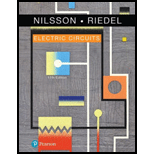
Concept explainers
(a)
Find the values of average power
(a)
Answer to Problem 1P
The values of
Explanation of Solution
Given data:
From the given expressions, the required parameters are written as follows:
Formula used:
Write the expression for average power as follows:
Here,
Write the expression for reactive power as follows:
Calculation:
Substitute 100 V for ,
As the average power is obtained with positive sign, the average is absorbed from the terminals of the box in the given circuit.
Substitute 100 V for ,
As the reactive power is obtained with positive sign, the magnetizing VARs are absorbed from the terminals of the box in the given circuit.
Conclusion:
Thus, the values of
(b)
Find the values of average power
(b)
Answer to Problem 1P
The values of
Explanation of Solution
Given data:
From the given expressions, the required parameters are written as follows:
Calculation:
Substitute 40 V for ,
As the average power is obtained with positive sign, the average is absorbed from the terminals of the box in the given circuit.
Substitute 40 V for ,
As the reactive power is obtained with negative sign, the magnetizing VARs are delivered to the terminals of the box in the given circuit.
Conclusion:
Thus, the values of
(c)
Find the values of average power
(c)
Answer to Problem 1P
The values of
Explanation of Solution
Given data:
From the given expressions, the required parameters are written as follows:
Calculation:
Rewrite the given expression of current as follows:
Therefore, the value of
Substitute 400 V for ,
As the average power is obtained with negative sign, the average is delivered to the terminals of the box in the given circuit.
Substitute 400 V for ,
As the reactive power is obtained with negative sign, the magnetizing VARs are delivered to the terminals of the box in the given circuit.
Conclusion:
Thus, the values of
(d)
Find the values of average power
(d)
Answer to Problem 1P
The values of
Explanation of Solution
Given data:
From the given expressions, the required parameters are written as follows:
Calculation:
Rewrite the given expression of voltage as follows:
Therefore, the value of
Substitute 200 V for ,
As the average power is obtained with negative sign, the average is delivered to the terminals of the box in the given circuit.
Substitute 200 V for ,
As the reactive power is obtained with positive sign, the magnetizing VARs are absorbed from the terminals of the box in the given circuit.
Conclusion:
Thus, the values of
Want to see more full solutions like this?
Chapter 10 Solutions
Electric Circuits. (11th Edition)
 Introductory Circuit Analysis (13th Edition)Electrical EngineeringISBN:9780133923605Author:Robert L. BoylestadPublisher:PEARSON
Introductory Circuit Analysis (13th Edition)Electrical EngineeringISBN:9780133923605Author:Robert L. BoylestadPublisher:PEARSON Delmar's Standard Textbook Of ElectricityElectrical EngineeringISBN:9781337900348Author:Stephen L. HermanPublisher:Cengage Learning
Delmar's Standard Textbook Of ElectricityElectrical EngineeringISBN:9781337900348Author:Stephen L. HermanPublisher:Cengage Learning Programmable Logic ControllersElectrical EngineeringISBN:9780073373843Author:Frank D. PetruzellaPublisher:McGraw-Hill Education
Programmable Logic ControllersElectrical EngineeringISBN:9780073373843Author:Frank D. PetruzellaPublisher:McGraw-Hill Education Fundamentals of Electric CircuitsElectrical EngineeringISBN:9780078028229Author:Charles K Alexander, Matthew SadikuPublisher:McGraw-Hill Education
Fundamentals of Electric CircuitsElectrical EngineeringISBN:9780078028229Author:Charles K Alexander, Matthew SadikuPublisher:McGraw-Hill Education Electric Circuits. (11th Edition)Electrical EngineeringISBN:9780134746968Author:James W. Nilsson, Susan RiedelPublisher:PEARSON
Electric Circuits. (11th Edition)Electrical EngineeringISBN:9780134746968Author:James W. Nilsson, Susan RiedelPublisher:PEARSON Engineering ElectromagneticsElectrical EngineeringISBN:9780078028151Author:Hayt, William H. (william Hart), Jr, BUCK, John A.Publisher:Mcgraw-hill Education,
Engineering ElectromagneticsElectrical EngineeringISBN:9780078028151Author:Hayt, William H. (william Hart), Jr, BUCK, John A.Publisher:Mcgraw-hill Education,





